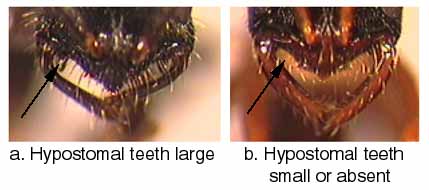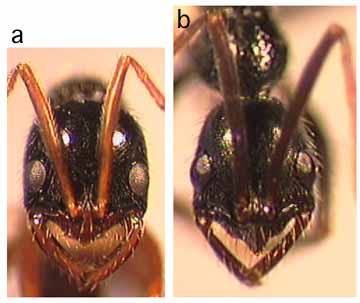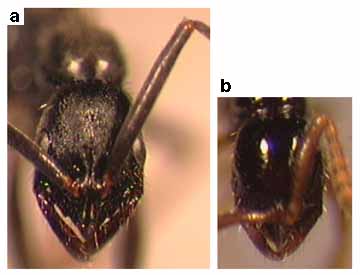
| Genus List | Species List |Genus Overview |
Key to Leptogenys Species Known from Costa Rica, Based on Workers
10a. When mandibles are in their usual resting position, with tips crossed, they project beyond anterior border of clypeus, leaving a distinct gap; clypeus reduced, leaving labrum largely exposed: 100
10b. In usual resting position, mandibles flush against anterior border of clypeus; clypeus large and triangular, completely concealing labrum: 400

100a. Hypostomal teeth strongly developed, in full-face view projecting conspicuously into gap between clypeus and mandibles: 200
100b. Hypostomal teeth reduced, barely or not visible in full-face view: 250

200a. Dorsal and posterior faces of petiole meeting at an acute angle, forming a short, posteriorly directed tooth; HW about 1.40mm; face coarsely punctate throughout: JTL-007
200b. Petiolar node subcuboidal, dorsal and posterior faces meeting at a rounded right angle; HW about 1.07mm; face smooth and shiny medially: JTL-004

250a. Petiole in lateral view without an overhanging dorsoposterior tooth or point, generally convex or with a blunt angle, but never overhanging the posterior petiolar margin: JEL-sul
250b. Petiole with a dorsoposterior tooth, blunt point or crest that usually overhangs the posterior petiolar margin: 300
300a. Head subquadrate, not narrowed posteriorly; face smooth and shining; dorsal and posterior faces of petiole meeting at an acute angle, forming a posteriorly directed tooth; legs and scapes orange, contrasting with the dark brown head and mesosoma: pubiceps complex
300b. Head distinctly narrowed behind; face with large puncta (which may be dense or somewhat dispersed and shallow); dorsal and posterior faces of petiole meeting at nearly a right angle, not or only weakly produced as a posteriorly directed tooth; legs and scapes darker brown, not contrasting strongly with head and mesosoma: punctaticeps

400a. Petiolar node subcuboidal, with distinct vertical anterior and posterior faces in lateral view: 500
400b. Petiolar node relatively more elongate, with dorsal face sloping toward anterior foramen, anterior face very short or confluent with dorsal face: 600

500a. Face densely punctate: 505
500b. Face smooth and shining: 510

505a. Postpetiolar tergite opaque and densely punctate, the space surrounding each puncture equal to or less than the diameter of each puncture; dorsal face of propodeum areolate-rugulose anterad, posterad densely punctate to imbricate; posterior face flat, with fine transverse parallel striae: JEL-for
505b. Postpetiolar tergite mostly smooth and shining with sparse punctulae, the space surrounding each puncture many times greater than the diameter of each puncture; dorsal face of propodeum punctate to transversely striate-punctate; posterior face transversely striate, striae becoming progressively coarser posterad: JTL-001
510a. Mesonotum longer than wide, anterior mesopleuron with laterally projecting fin-like lobe, mandible triangular: JEL-pin
510b. Mesonotum wider than long, anterior mesonotum without fin like lobe, mandible with semiparallel internal and external margins: 520
520a. Petiolar node elongate in dorsal view, the anterior margin at most half as wide as the posterior margin: JEL-qua
520b. Petiolar node subquadrate in dorsal view, the anterior margin more than half as wide as the posterior margin: 550
550a. Petiole relatively more elongate; first and second funicular segments relatively elongate; HW about 0.6-0.7mm: josephi
550b. Petiole relatively shorter; first and second funicular segments shorter; HW about 0.5-0.6mm: pusilla

600a. Masticatory margin of mandible subequal in length to basal margin, and with 4-5 blunt teeth; dorsal face of propodeum transversely striate; petiole in dorsal view not as strongly narrowed anteriorly, sides converging anteriorly but not concave: famelica
600b. Masticatory margin of mandible shorter than basal margin, and without teeth; dorsal face of propodeum punctate (grading to transverse striae on posterior face); petiole in dorsal view strongly constricted anteriorly, sides concave: imperatrix
